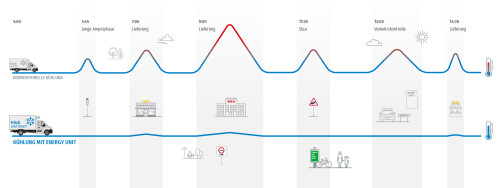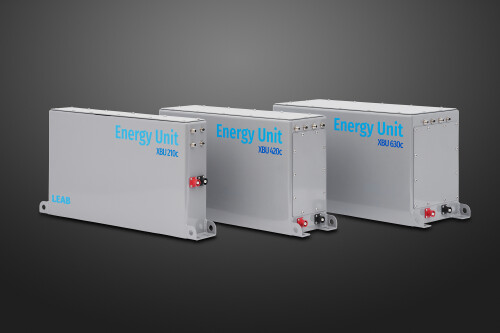
Compared to conventional load compartment cooling, the Energy Unit results in much lower temperature fluctuations.
Fresh food logistics experts, medicine transporters and frozen food suppliers know the problem: every time the engine stops the active cooling system comes to a partial or complete standstill, and frequent opening of the cargo area doors has a visible effect on the temperature recorder. The requirements and expectations for the supply chain of temperature-controlled transports have been constantly changing for years. This affects not only the goods themselves, but also the relevant legal requirements. In this blog article, we look at what this means in detail and how our ePTO system - the Energy Unit - can be used to avoid temperature fluctuations and consistently comply with regulations.
When it comes to temperature-controlled transport, the temperature range is quite wide: It ranges from double-digit sub-zero temperatures to as low as 25°C.
Deep-freezing: –18°C to - 20°C
Fresh food service: 0°C to 8°C
Flowers and plants: 5°C to 20°C
Medication transport: 15°C to 25°C
The key here is above all the consistency of the desired temperature range. For example, it can be extremely important for paints or varnishes not to freeze under any circumstances - so temperature-controlled does not necessarily mean ice-cooled.
Whether transporting fresh and chilled goods, paints, varnishes, plants or medicines:
Due to the constant increase in technical and legal requirements in areas such as ATP, GDP or HACCP, it is becoming increasingly important to guarantee uninterrupted cooling in temperature-controlled transport.
Inner-city driving bans, low payload weights, automatic start-stop systems or temperature detection also contribute to this.
Together with the World Economic Forum, the renowned consulting firm McKinsey 2020 has published a joint study. This study specifically examined the anticipated demand for last-mile deliveries.
One finding was that the demand for deliveries on this last transport stage from the final logistics centre to the end customer will increase by 78 percent worldwide.
Added to the above-mentioned ever increasing legal requirements for emissions and noise pollution, it quickly becomes clear why combustion engines and last mile delivery can no longer have a meaningful future together.
In addition to open doors, idling and standing times are a problem. If the engine is at a standstill, the cooling unit is not running either. Even when idling, the cooling capacity drops by up to 40 percent.
Technical solutions to guarantee a constantly high cooling capacity are electrical systems supplied by lithium batteries - or in other words: ePTOs. With such surface-mounted battery systems on board, critical temperature fluctuations in the cold room are a thing of the past. Unlike the combustion engine, a battery provides sufficient energy to keep the cooling system running even when the vehicle is stationary.

Compared to conventional load compartment cooling, the Energy Unit results in much lower temperature fluctuations.
Thanks to the Energy Unit, temperature fluctuations are avoided and regulations are consistently complied with – on the last mile and in intercity transport.
In very simplified terms, the Energy Unit is a power supply system at the heart of which lies a lithium-based, extremely compact and powerful power bank. We have specially developed this battery pack. It is called XBU and is available for combustion and electric vehicles. The XBU comes in three different capacities:
210 Ah
420 Ah
630 Ah
Today, modern lithium technology makes it possible to provide such high amounts of energy quickly, effectively and permanently.
The system can be used for example in refrigerated vehicles to provide enough energy for a whole working day – without having to recharge.
At night, the integrated charger provides sufficient replenishment, and at the same time the cargo area can be pre-fitted – all via one connection. For vehicles with combustion engines, additional recharging is carried out while driving by the optional charge booster. Quick intermediate charging via a socket is also possible.

The three versions of the XBU.
Naturally, generator operation can still be used for the cooling system. As soon as the vehicle engine stops turning, an automatic switchover to mains operation can take place, depending on the cooling system used.
This results in numerous advantages for temperature-controlled transports:
Buffering of downtimes
No interruption of the cooling chain
Silent operation
Fuel savings
No emissions on site
The power supply system is not only predestined for temperature-controlled transport - it can also be excellently used in inspection or service vehicles as well as in test vehicles.